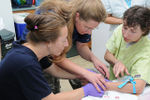Talk:Licensed practical nurse
Parking original content for possible later re-inclusion - while page is rewritten.--Ashcraft - (reply) 15:23, 12 April 2018 (EDT)
Licensed practical nurses (LPNs) also called licensed vocational nurses (LVNs) provide basic nursing care. They work under the direction of registered nurses and doctors.[1]
These nurses do not have the caliber of education in their repertoire as compared to the education need in a registered nurse. In some cases being a licensed practical nurse is a step to becoming a registered nurse (RN). Even though these nurses may seem low in the hierarchy, they are very important in keeping the medical field stable and moving efficiently.
Education
Those wanting to become a licensed practicing nurse can find a program in many places. The program takes about one to one and a half years to complete or 18 months. Community colleges, vocational technical schools, high school, hospitals, colleges, and universities are some locations that an LPN program can be found. Online programs are also available. The programs must be accredited by the National League of Nursing Accrediting Agency (NLNAC). The entire LPN program can cost from a range of $4000 to $20,000. The average price for the tuition is about $10,000 to $15,000 around the nation. Along with the tuition being paid books, a stethoscope, uniform and nursing supplies, and the NCLEX-PN test are all other fees that will need to be taken care of. In considering where to study this program, it is good to compare the different programs' pass rate of the first time test taker's of the NCLEX-PN. [2]
Duties
Licensed practicing nurses (LPN) do a variety of tasks in their job position. LPN's work under the supervision of Registered nurses and doctors. The first thing at an LPN does is record the patients medical history. Licensed practicing nurses report patients’ status and concerns to registered nurses and doctors, enter information into computer systems, and take vital signs, such as blood pressure, temperature, and weight. They care for the patients by administrating basic wound care including cleaning and bandaging injured areas, insert catheters, and provide for the basic comfort of patients, such as helping them bathe or dress. [3] They also give injections of medication, immunizations, and medication as prescribed by a physician. Those are typical LPN duties, but they also do other tasks in certain job settings. In hospitals licensed practicing nurses manage IV, monitor fluid and food intake and output, and supervise certified nursing assistants. In nursing homes and rehabilitation centers they must assess patients' mental health, observing of patients' skin for potential bed sores, and provide support emotionally. LPN's do more paperwork in clinics such as scheduling appointments, keeping medical records current, billing patients, and working with insurance companies. [4]
Pay
Wages ranged from $30,970 to $57,360 for those who are in the Licensed practical nursing field. The average pay as of 2012 is $42,400. General medical and surgical hospitals employed 124,400 LPNs. [5]
- ↑ Licensed Practical and Licensed Vocational Nurses U.S. Bureau of Labor Statistics Web. Publish January 8, 2014.
- ↑ LPN School Practicalnursing.org. Web. date of accessed 5/19/2015 (specify which).
- ↑ Licensed Practical and Licensed Vocational Nurses Bureau of Labor Statistics. Web. 1/8/2015 last update
- ↑ Job Description Of an LPN Licensed Practical Nursing. Web. 1/9/15 date of access.
- ↑ http://work.chron.com/much-lpn-make-working-hospital-24429.html

